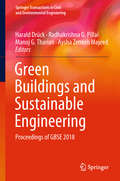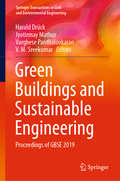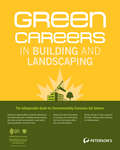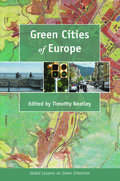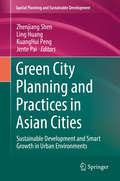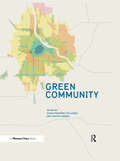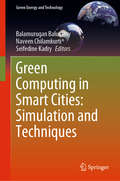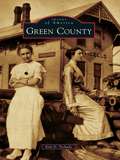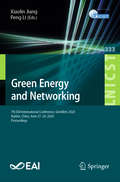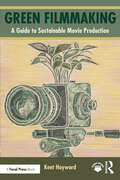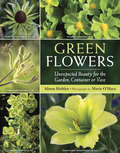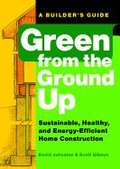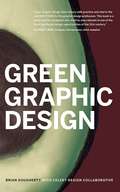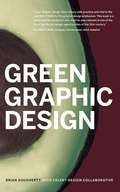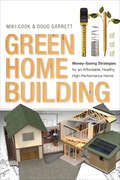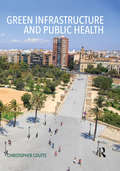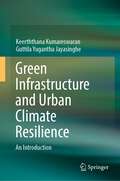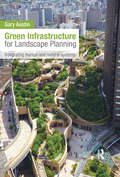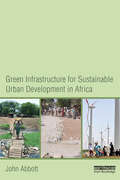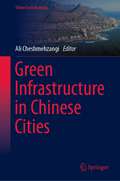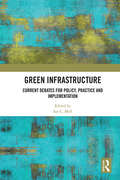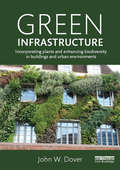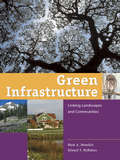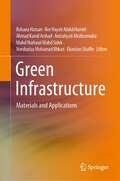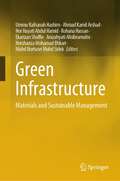- Table View
- List View
Green Buildings and Sustainable Engineering: Proceedings of GBSE 2018 (Springer Transactions in Civil and Environmental Engineering)
by Harald Drück Radhakrishna G. Pillai Manoj G Tharian Aysha Zeneeb MajeedThis book comprises the proceedings of the International Conference on Green Buildings and Sustainable Engineering (GBSE 2018), which focused on the theme “Transforming our Built Environment through Innovation and Integration towards a Smart and Sustainable Future”. The papers included address all aspects of green buildings and sustainability practices in civil engineering, and offer a valuable reference resource for researchers, practitioners, and policy makers.
Green Buildings and Sustainable Engineering: Proceedings of GBSE 2019 (Springer Transactions in Civil and Environmental Engineering)
by Jyotirmay Mathur Harald Drück Varghese Panthalookaran V. M. SreekumarThis book comprises the proceedings of the International Conference on Green Buildings and Sustainable Engineering (GBSE 2019), which focused on the theme “Ecotechnological and Digital Solutions for Smart Cities”. The papers included address all aspects of green buildings and sustainability practices in civil engineering, and focus on ways and means of reducing pollution and degradation of the environment through efficient usage of energy and water. The book will prove a valuable reference resource for researchers, practitioners, and policy makers.
Green Careers in Building and Landscaping: Professional and Skilled Jobs
by Peterson'sAs part of Peterson's Green Careers in Building and Landscaping, this eBook offers detailed information on various careers in the following: building design and construction; installation, You'll also find up-to-date data on job trends, work environment, career paths, earning potential, education/license requirements, and contact information for additional resources. Bonus sections include "What Does Being Green Mean," a look at the current interest in sustainability, and "Essays on the Importance of Sustainability," inspirational and insightful essays on the importance of sustainability, written by folks at the forefront of environmental organizations, university sustainability efforts, and college training programs. For more information see Peterson's Green Careers in Building and Landscaping.
Green Cities of Europe: Global Lessons on Green Urbanism
by Timothy Beatley Maria Jaakkola Wulf Daseking Michaela Bruel Lucie Laurian Dale MedearisIn the absence of federal leadership, states and localities are stepping forward to address critical problems like climate change, urban sprawl, and polluted water and air. Making a city fundamentally sustainable is a daunting task, but fortunately, there are dynamic, innovative models outside U.S. borders. Green Cities of Europe draws on the world's best examples of sustainability to show how other cities can become greener and more livable. Timothy Beatley has brought together leading experts from Paris, Freiburg, Copenhagen, Helsinki, Heidelberg, Venice, Vitoria-Gasteiz, and London to illustrate groundbreaking practices in sustainable urban planning and design. These cities are developing strong urban cores, building pedestrian and bicycle infrastructure, and improving public transit. They are incorporating ecological design and planning concepts, from solar energy to natural drainage and community gardens. And they are changing the way government works, instituting municipal "green audits" and reforming economic incentives to encourage sustainability. Whatever their specific tactics, these communities prove that a holistic approach is needed to solve environmental problems and make cities sustainable. Beatley and these esteemed contributors offer vital lessons to the domestic planning community about not only what European cities are doing to achieve that vision, but precisely how they are doing it. The result is an indispensable guide to greening American cities. Contributors include: Lucie Laurian (Paris) Dale Medearis and Wulf Daseking (Freiburg) Michaela Brüel (Copenhagen) Maria Jaakkola (Helsinki) Marta Moretti (Venice) Luis Andrés Orive and Rebeca Dios Lema (Vitoria-Gasteiz) Camilla Ween (London)
Green City Planning and Practices in Asian Cities: Sustainable Development And Smart Growth In Urban Environments (Strategies for Sustainability)
by Zhenjiang Shen Ling Huang KuangHui Peng Jente PaiUrban planners across the world are faced with sustainable development issues in their work, especially when they are tasked with creating green cities or where sustainable and smart growth in urban settings are set as primary goals. This book introduces green city planning and practices from the three dimensions of green-building innovation, community development and smart city strategies, and argues that effective implementation of green city planning are a necessary pre-condition for reaching sustainable urban development. A range of authors representing a broad disciplinary spectrum bring together the different standards of green building methods and urban design techniques and clearly sketch the roles of both spatial designers and urban researchers in the implementation of green city planning at regional, community and single-building level in order to arrive at an integrated approach across different scales.
Green Community
by Timothy Mennel Susan Piedmont-PalladinoThe health of our planet and ourselves depends on how we plan, design, and construct the world between our buildings. Our increasing dependence on fossil fuels over the last century has given us unprecedented individual mobility and comfort, but the consequences are clear. Climate change, sprawl, and reliance on foreign oil are just a few of the challenges we face in designing new-and adapting existing-communities to be greener. Based on the National Building Museum's Green Community exhibition, this book is a collection of thought-provoking essays that illuminate the connections among personal health, community health, and our planet's health. Green Community brings together diverse experts, each of whom has a unique approach to sustainable planning, design, politics, and construction.
Green Computing in Smart Cities: Simulation and Techniques (Green Energy and Technology)
by Naveen Chilamkurti Seifedine Kadry Balamurugan BalusamyThe book collects the latest research and thinking from international experts on green computing and the smart city. The financial and environmental costs of energy are a concern in smart cities due to the high usage of computing, technology, security, IoT, communications, traffic, and other technologies. This book tackles this problem with a focus on computing, reporting on various approaches being taken worldwide, illustrated by several international case studies demonstrating these approaches. Researchers use this book as an up-to-date reference and engineers use it as a guide for the design and implementation of real solutions.
Green County
by Kim TschudyThis book presents a glimpse into Green County's colorful and historic past. Not only are the communities of present-day Green County included, but also within are the ghost towns Attica, Dayton, Dutch Hollow, Martintown, Postville, and Schultz. While far from a complete photographic history of Green County, the reader will get a glimpse of many of the lesser-known facets of its history, both physical and personal. It is the author's hope that this book will serve as a beginning point for the reader to venture deeper into Green County's collective past.
Green Energy and Networking: 7th EAI International Conference, GreeNets 2020, Harbin, China, June 27-28, 2020, Proceedings (Lecture Notes of the Institute for Computer Sciences, Social Informatics and Telecommunications Engineering #333)
by Peng Li Xiaolin JiangThis book constitutes the refereed post-conference proceedings of the 7th International Conference on Green Energy and Networking, GreeNets 2020, held in Harbin, China, in June 2020. Due to VOVID-19 pandemic the conference was held virtually. The 35 full papers were selected form 87 submissions and are grouped in tracks on Green Communication; Green Energy; and Green Networking.
Green Filmmaking: A Guide to Sustainable Movie Production
by Kent HaywardBeyond the principles of reduce, reuse, recycle, this book looks at how every department on a production can minimize its environmental impact.Is your filmmaking contributing to the environmental crisis, or is it part of the solution? How can film students make movies in a more ecologically friendly way so that our planet can continue to be inhabited by humans who watch their films? This book suggests step-by-step ways that each person and department on a film’s production can make simple changes to reduce their project’s environmental footprint, from including climate content to offering vegetarian craft service options.It is an essential guide for film students, graduates, and professionals engaged in the practice of making movies.
Green Flowers: Unexpected Beauty for the Garden, Container or Vase
by Alison Hoblyn Marie O'HaraGreen in the garden is at once the most common color of foliage and the rarest color found in flowers. Whether you're a home gardener looking for a jolt of freshness or a floral designer seeking inspiration, this charming collection of unexpected plants provides a palette of flowering greens for year-round display. Combining Marie O'Hara's sumptuous photography and Alison Hoblyn's evocative text, Green Flowers explores the history, botany, care, and cultivation of green-flowered plants. The hand-picked selection includes trees, grasses, vines and climbers, annuals, perennials, bulbs, wildflowers, exotics, orchids, edible plants, and water garden plants. The appeal of the selection is broad: Jack-in-the-pulpit provides curiosity; fritillaries and columbines lend quiet beauty; and green roses, hellebores, and irises are an excellent foil to their more colorful companions. Eighty-four plants are included in all. Complete tips on growing and arranging the plants are given for each entry, as well as an account of the interesting myths, history, and lore.
Green From the Ground Up: Sustainable, Healthy, And Energy-Efficient Home Construction (Builder's Guide Ser.)
by David Johnston Scott GibsonMy passion for green building is based on experience. I know that building green results in better houses and that it improves the lives of the people who live in them, not to mention the health of our planet.
Green Graphic Design
by Brian DoughertyThe goal of Celery Design Collaborative in Berkeley, CA, is to do graphic design that "tastes good and is good for you. " Co-founder Doughterty discusses designing backwards, packaging waste reduction, using alternative fibers, and other innovative ways to meet the challenges of green design. Aptly printed on recycled paper with low-VOC ink, the guide includes a sustainability scorecard for assessing which materials and processes represent the greenest choice in a particular situation, ecological guide to paper, glossary, and resources. Annotation ©2009 Book News, Inc. , Portland, OR (booknews. com)
Green Graphic Design
by Brian Dougherty Celery Design CollaborativeCan a graphic designer be a catalyst for positive change? Green Graphic Design reframes the way designers can think about the work they create, while remaining focused on cost constraints and corporate identity. Simple, eco-innovative changes are demonstrated in all phases of the design process, including:· Picking projects · Strategizing with clients· Choosing materials for manufacture and shipping· Understanding users· Picking ink and paper for printing· Binding · Packing final products· Building strong brands · Working with clients to foster transparency and corporate social responsibilityFully illustrated and packed with case studies of green design implementation, this reference guide more than inspires; a "sustainability scorecard" and a complete glossary of key terms and resources ensure that anyone in the design field can implement practical green solutions. Green Graphic Design is an indispensable resource for graphic designers ready to look to the future of their business and the environment.
Green Home Building: Money-Saving Strategies for an Affordable, Healthy, High-Performance Home
by Doug Garrett Miki CookA comprehensive guide to building green on any budget.According to conventional wisdom, building a green home is an expensive endeavor. The standard approach treats green as an add-on, tacking "premium" products, finishes, and equipment onto a traditional home design. As a result, many green home projects end up over budget or fail to achieve their environmental and performance goals.Green Home Building explodes the myth that green homes have to cost more. Using proven methods based on applied building science, the authors show how to:Lower base construction costs to provide funding for high performance upgradesAchieve a net-zero energy home, including "zero-ing" water, waste, carbon, and associated costs within fifteen yearsLive affordably into the future, despite anticipated rising costs for fuel, water, materials, taxes, and health careThis comprehensive guide to building green on any budget defines the strategies that maximize the return on green investments. Written for anyone who has ever been swayed by the argument that the price tag limits how green a home can be, Green Home Building is a must-read for builders, contractors, architects, designers, and homeowners.Miki Cook is a green building and sustainability consultant who has dedicated her career to educating contractors and the public on the strategies, methods, and benefits of green homes.Doug Garrett has trained thousands of homebuilders, architects, and sub-contractors to build energy-efficient homes using applied building science to improve comfort, durability, and healthfulness while meeting or exceeding the energy code.
Green Infrastructure and Public Health
by Christopher CouttsThere is a growing body of knowledge revealing a sweeping array of connections between public health and green infrastructure – but not until now have the links between them been brought together in one comprehensive book. Green Infrastructure and Public Health provides an overview of current research and theories of the ecological relationships and mechanisms by which the environment influences human health and health behaviour. Covering a broad spectrum of contemporary understanding, Coutts outlines: public health models that explicitly promote the importance of the environment to health ways in which the quality of the landscape is tied to health challenges of maintaining viable landscapes amidst a rapidly changing global environment This book presents the case for fundamental human dependence on the natural environment and creates a bridge between contemporary science on the structure and form of a healthy landscape and the myriad ways that a healthy landscape supports healthy human beings. It presents ideal reading for students and practitioners of landscape architecture, urban design, planning, and health studies.
Green Infrastructure and Urban Climate Resilience: An Introduction
by Guttila Yugantha Jayasinghe Keerththana KumareswaranThis book aims to cover most subject areas of green infrastructure such as components, multi-functionality, and integration to build environment, contribution to urban sustainability, sustainable and smart city development, urban climate change nexus, green buildings and rating systems, economic assessment, and quantification of green infrastructure. The impending climate crisis, as well as the ongoing COVID-19 pandemic, has highlighted the importance of green infrastructure in and around cities, prompting a call for more functional and sustainable urban planning and design. A number of recent studies have shown that green infrastructure provides a wide range of ecosystem functions and services critical to human well-being and urban sustainability, which is especially important during climatic and health crises. In this book, the authors emphasize the importance of existing green infrastructure in coping with climate change-induced stresses, such as increasing climate variability and extreme temperature and precipitation events, as well as contributing to urban dwellers' physical and mental health. Green infrastructure, in both cases, plays a significant role in providing urban areas with resilience capacity, which is critical to urban sustainability. The authors also emphasize the importance of expanding and improving green infrastructure, particularly in vulnerable areas, through integrative and participatory processes.Appropriate integration of green-gray infrastructure and development of climate resilient cities is the core theme of this publication. Further, it emphasizes sustainable development which has become an imperative requirement to the world to move fore and climate change-built environment nexus, the most critical global crisis. Though several books were published globally on the green infrastructure and urban resilience individually, books are rarely published combining both disciplines. This book identifies and addresses the gap through comprehensively discussing on both interlinked areas which is essential for the sustainable urban development. Further, it explores on urban climate resilience, urban sprawl, urbanization, resilience drivers, essentials of city resilience, policy implications, challenges, and future perspectives. This book is a useful fundamental guide in practical applications of green infrastructure in built environment in sustainability context. Further, it enlightens on the significance of transforming the conventional building construction trend to sustainable urban planning designs and building development, exploring on the strategic pathway on building urban climate resilience while signifying the importance of healthy built environment through discussing on the nexus between climate change and built environment.
Green Infrastructure for Landscape Planning: Integrating Human and Natural Systems
by Gary AustinGreen infrastructure integrates human and natural systems through a network of corridors and spaces in mixed-use and urban settings. Austin takes a broad look at green infrastructure concepts, research and case studies to provide the student and professional with processes, criteria and data to support planning, design and implementation. Key topics of the book include: The benefits of green infrastructure as a conservation and planning tool Requirements of ecosystem health Green infrastructure ecosystem services that contribute to human physical and psychological health Planning processes leading to robust green infrastructure networks Design of green infrastructure elements for multiple uses. The concept of ecosystem services is extensively developed in this book, including biological treatment of stormwater and wastewater, opportunities for recreation, urban agriculture and emersion in a naturalistic setting. It defines planning and design processes as well as the political and economic facets of envisioning, funding and implementing green infrastructure networks. The book differs from others on the market by presenting the technical issues, requirements and performance of green infrastructure elements, along with the more traditional recreation and wildlife needs associated with greenway planning, providing information derived from environmental engineering to guide planners and landscape architects.
Green Infrastructure for Sustainable Urban Development in Africa
by John AbbottThis book shows for the first time how green infrastructure can work in an African urban context. On one level it provides a major rethinking of the role of infrastructure in urban society since the creation of networked infrastructure in the early twentieth century. On another, it explores the changing paradigms of urban development through the fundamental question of how decisions are made. With a focus on Africa's fast-growing secondary towns, where 70 per cent of the urban population live, the book explains how urban infrastructure provides the key to the relationship between economic development and social equity, through the mediation of natural resources. Adopting this view enables investment to be channelled more effectively to provide the engine for economic growth, while providing equitable services for all residents. At the same time, the mediation of resource flows integrates the metabolism of the city into the wider ecosystem. This vision leads to a new way of thinking about infrastructure, giving clear definition to the concept of green infrastructure. On the basis of research gathered throughout an extensive career, John Abbott draws in particular from his experience in Ethiopia to demonstrate the ways in which infrastructure needs to respond to the economies, societies and natural environments of twenty-first century urban Africa.
Green Infrastructure in Chinese Cities (Urban Sustainability)
by Ali CheshmehzangiSince 2014, and the start of the New-type Urbanization Plan (NUP), we see a turning point in the sustainability agenda of China. One of the main indicators is greening cities and the built environments, which will be covered holistically in this edited book. From the perspective of green infrastructure, in particular, the book approaches key areas of ‘forest city development’, ‘sponge city program’, ‘green roofing’, ‘nature-based solutions’, ‘urban farming’, ‘eco-city development’, etc. This is the first time that such important areas of research come together under the perspective of green Infrastructure. The results would be beneficial to policymakers, practitioners, and researchers in China and across the globe. The comprehensive set of findings from this book will benefit other countries, as we aim to highlight some of the best practices of the current age.The main aim of the book is to put together an excellent group of scholars and practitioners from the field, focusing on the topic of ‘Green Infrastructure in Chinese Cities’. In doing so, we aim to cover some of the key ‘best practices’ for sustainable urbanism. Divided into four parts, the book covers four key areas of (1) Policy Interventions, (2) Planning Innovation, (3) Design Solutions, and (4) Technical Integration. In doing so, we cover an array of best practices related to green infrastructures of various types and their impacts on cities and communities in China.We expect the book to be a valuable resource for researchers in the areas of sustainability, urbanism, urban planning, urban geography, urban design, geographical sciences, environmental sciences, landscape architecture, and urban ecology. The book covers essential factors such as policy, regulations, and programs (in Part 1), planning paradigms and their impacts on urban development (in Part 2), integrated design solutions that suggest sustainable urbanization progression (in Part 3), and technical knowledge that would be utilized for the future development of green infrastructure practices in China and beyond. Lastly, this edited book aims to provide a collaborative opportunity for experts and researchers of the field, who could contribute to the future pathways of sustainable urbanization of China. Lessons extracted from these contributions could be utilized for other contexts, which will benefit a wider group of stakeholders.
Green Infrastructure: Current Debates for Policy, Practice and Implementation
by Ian C. MellOur understandings of the landscapes around us are constantly changing. How we interact with, manage and value these spaces is important, as it helps us to ensure we live in attractive, functional and sustainable places. Green Infrastructure planning is the current ‘go-to’ approach in landscape planning that incorporates human-environmental interactions, understandings of ecology and how socio-cultural factors influence our use of parks, gardens and waterways. This book explores several interpretations of Green Infrastructure bringing together case studies of policy, practice, ecological change and community understandings of landscape. Focusing on how planning policy shapes our interactions with the landscape, as individuals and communities, the book discusses what works and what needs to be improved. It examines how environmental management can promote more sustainable approaches to landscape protection ensuring that water resources and ecological communities are not harmed by development. It also asks what the economic and community values of Green Infrastructure are to illustrate how different social, ecological and political factors influence how our landscapes are managed. The central message of the book focusses on the promotion of multi-functional nature within urban landscapes that helps people, the economy and the environment to meet the challenges of population, infrastructure and economic change. The chapters in this book were origianally published as a special issue in Landscape Research.
Green Infrastructure: Incorporating Plants and Enhancing Biodiversity in Buildings and Urban Environments (Routledge Studies in Urban Ecology)
by John W. DoverWith more than half of the world's population now living in urban areas, it is vitally important that towns and cities are healthy places to live. The principal aim of this book is to synthesize the disparate literature on the use of vegetation in the built environment and its multifunctional benefits to humans. The author reviews issues such as: contact with wildlife and its immediate and long-term effects on psychological and physical wellbeing; the role of vegetation in removing health-damaging pollutants from the air; green roofs and green walls, which provide insulation, reduce energy use and decrease the carbon footprint of buildings; and structural vegetation such as street trees, providing shading and air circulation whilst also helping to stop flash-floods through surface drainage. Examples are used throughout to illustrate the practical use of vegetation to improve the urban environment and deliver ecosystem services. Whilst the underlying theme is the value of biodiversity, the emphasis is less on existing high-value green spaces (such as nature reserves, parks and gardens), than on the sealed surfaces of urban areas (building surfaces, roads, car parks, plazas, etc.). The book shows how these, and the spaces they encapsulate, can be modified to meet current and future environmental challenges including climate change. The value of existing green space is also covered to provide a comprehensive textbook of international relevance.
Green Infrastructure: Linking Landscapes and Communities
by Edward T. Mcmahon Lydia Bergen Mark A. Benedict Mark A. The Conservation FundWith illustrative and detailed examples drawn from throughout the country, Green Infrastructure advances smart land conservation: large scale thinking and integrated action to plan, protect and manage our natural and restored lands. From the individual parcel to the multi-state region, Green Infrastructure helps each of us look at the landscape in relation to the many uses it could serve, for nature and people, and determine which use makes the most sense. In this wide-ranging primer, leading experts in the field provide a detailed how-to for planners, designers, landscape architects, and citizen activists
Green Infrastructure: Materials and Applications
by Rohana Hassan Nor Hayati Abdul Hamid Ahmad Kamil Arshad Anizahyati Alisibramulisi Muhd Norhasri Muhd Sidek Norshariza Mohamad Bhkari Ekarizan ShaffieThis book presents the meaning of green infrastructure and its concerns to the contribution of materials and applications. It explores the evolving contested material under “green infrastructure” covering timber, concrete, soil, and pavement. It discusses the resistance to the ambiguity of managing the construction of green infrastructure and drawing on wider debates around applications and processes on construction. These contributions are by no means definitive, but rather an attempt to provide a detached and holistic perspective on the engineering “green infrastructure” concept.
Green Infrastructure: Materials and Sustainable Management
by Rohana Hassan Nor Hayati Abdul Hamid Ahmad Kamil Arshad Anizahyati Alisibramulisi Muhd Norhasri Muhd Sidek Norshariza Mohamad Bhkari Ekarizan Shaffie Ummu Raihanah HashimThis second volume of "Green Infrastructure" provides a comprehensive exploration of both established and evolving green infrastructure materials, along with sustainable practices across various facets that hold the potential to shape our future. Emphasizing emerging domain materials such as timber, concrete, soil, and pavement, among others, this book delves into the pivotal role these elements play in fostering sustainable urban development. It underscores the significance of these materials in preserving ecosystem services and constructive management, thus leading to the attainment of manifold advantages. Bridging a critical void in the existing literature, this volume serves as an indispensable resource, serving to guide forthcoming research endeavors concerning green materials and their applications within the realm of sustainability.
